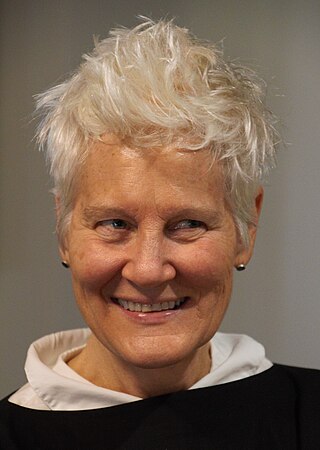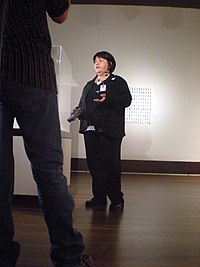
The Blackfoot Confederacy, Niitsitapi, or Siksikaitsitapi, is a historic collective name for linguistically related groups that make up the Blackfoot or Blackfeet people: the Siksika ("Blackfoot"), the Kainai or Blood, and two sections of the Peigan or Piikani – the Northern Piikani (Aapátohsipikáni) and the Southern Piikani. Broader definitions include groups such as the Tsúùtínà (Sarcee) and A'aninin who spoke quite different languages but allied with or joined the Blackfoot Confederacy.

The Kainai Nation is a First Nations band government in southern Alberta, Canada, with a population of 12,800 members in 2015, up from 11,791 in December 2013.

The Piikani Nation is a First Nation, representing the Indigenous people in Canada known as the Northern Piikani or simply the Peigan.

Janet Cardiff is a Canadian artist who works chiefly with sound and sound installations, often in collaboration with her husband and partner George Bures Miller. Cardiff first gained international recognition in the art world for her audio walks in 1995. She lives and works in British Columbia, Canada.

The Eiteljorg Museum of American Indians and Western Art is an art museum in downtown Indianapolis, Indiana, United States. The Eiteljorg houses an extensive collection of visual arts by indigenous peoples of the Americas as well as Western American paintings and sculptures collected by businessman and philanthropist Harrison Eiteljorg (1903–1997). The museum houses one of the finest collections of Native contemporary art in the world.
Laura Vickerson is a Canadian artist who works with mixed media in site-specific situations. She often includes discarded household items in her projects as a comment on changing trends, consumerism and human relationships with everyday objects. Vickerson was a professor in Craft and Emerging Media at the Alberta College of Art and Design, where she taught starting in 1989. Vikerson retired in 2020 and is now a Professor Emeritus.

Ann Hamilton is an American visual artist who emerged in the early 1980s known for her large-scale multimedia installations. After receiving her BFA in textile design from the University of Kansas in 1979, she lived in Banff, Alberta, and Montreal, Quebec, Canada before deciding to pursue an MFA in sculpture at Yale in 1983. From 1985 to 1991, she taught on the faculty of the University of California at Santa Barbara. Since 2001, Hamilton has served on the faculty of the Department of Art at the Ohio State University. She was appointed a Distinguished University Professor in 2011.

Rebecca Belmore is a Canadian interdisciplinary Anishinaabekwe artist who is notable for politically conscious and socially aware performance and installation work. She is Ojibwe and a member of Obishikokaang. Belmore currently lives in Toronto, Ontario.
Bonnie Devine is a Serpent River Ojibwa installation artist, performance artist, sculptor, curator, and writer from Serpent River First Nation, who lives and works in Toronto, Ontario. She is currently an associate professor at OCAD University and the founding chair of its Indigenous Visual Cultural Program.
Truman Tennis Lowe (Ho-Chunk) was an American sculptor and installation artist. A professor of fine art at the University of Wisconsin, Lowe also served as a curator of contemporary art at the National Museum of the American Indian. He is known for large site-specific installation pieces using natural materials.
Dana Claxton is a Hunkpapa Lakota filmmaker, photographer, and performance artist. Her work looks at stereotypes, historical context, and gender studies of Indigenous peoples of the Americas, specifically those of the First Nations. In 2007, she was awarded an Eiteljorg Fellowship for Native American Fine Art.
Elle-Máijá Apiniskim Tailfeathers is a Blackfoot and Sámi filmmaker, actor, and producer from the Kainai First Nation in Canada. She has won several accolades for her film work, including multiple Canadian Screen Awards.

Joane Cardinal-Schubert LL. D was a First Nations artist from Alberta, Canada. She was a member of the Royal Canadian Academy of Arts. She was an activist for Native sovereignty.

Mary Annora Brown L.L. D. (1899–1987), known as Annora Brown, was a Canadian visual artist whose work encompassed painting and graphic design. She was best known for her depictions of natural landscapes, wildflowers, and First Nations communities in Canada. Much of her work thematically explored Albertan identity, though she remained relatively obscure in discussions of Canadian art.
Hannah Claus is a multidisciplinary visual artist of English and Kanien'kehá:ka (Mohawk) ancestries and is a member of the Mohawks of the Bay of Quinte First Nation.
Holly Wilson is a Native American artist from Oklahoma. She is an enrolled member of the Delaware Nation and is of Cherokee descent.
Teresa Marshall was born in 1962 in the town Truro, located in the province of Nova Scotia, Canada. She is a multimedia artist, which includes sculptures and installations. She also makes poetry and writes plays. She is Mi'kmaq and was raised on the Millbrook Reserve as well as on a military base. She was born into two different cultures. Mi'kmaq on her mother's side and Canadian on her father's. She is a member of the Millbrook First Nation. Her works show and describe the effects of racism and neocolonialism on the First Nations people. Coming from two different backgrounds, Marshall shows both the indigenous and non-native perspectives of her native community and how they were affected.

Terrance James Houle is an Internationally recognized Canadian interdisciplinary artist and member of the Kainai Nation and ancestry from the Sandy Bay Reservation, Manitoba. His Mother is Maxine WeaselFat from the Kainai Nation and Father Donald Vernon Houle from Sandy Bay Reservation in Manitoba, they are both 3rd generation Residential School attendees & reside on the Blood reservation in Southern Alberta, Canada. His work ranges from subversive to humorous absurdity to solemn and poetic artistic expressions. His work often relates to the physical body as it investigates issues of history, colonization, Aboriginal identity and representation in popular culture, as well as conceptual ideas based on memory, home, and reserve communities. Currently, He has co-directed a Short Animation Otanimm/Onnimm with his daughter Neko which is currently touring Film festivals, In Los Angeles, NYC, Toronto, New Zealand, Vancouver, Oxford & many more. Recently their short film won the prestigious Golden Sheaf Indigenous Award at Yorkton Film Festival and is Neko's First Award in Film at 17 years old.

Alexandra Haeseker is a Canadian painter, print maker, and installation artist, based in Calgary, Alberta. She is a professor emerita at Alberta University of the Arts. Her works can be found in public collections in Canada and internationally.
Luzene Hill is a Native American multimedia artist and citizen of the Eastern Band of Cherokee Indians. She combines performance with installation to reflect on violence against women, using lyrical abstraction to approach difficult topics. She is best known for her 2011-2015 work Retracing the Trace, an installation reflecting on the prevalence and pain of sexual assault through the lens of Hill's own experience. Her works primarily explore themes of the trauma and shame produced by various types of violence enacted against women and indigenous cultures and the transformative healing powers of art. Beyond the United States, Hill's art has exhibited internationally in Canada, Russia, Japan, and the United Kingdom.











